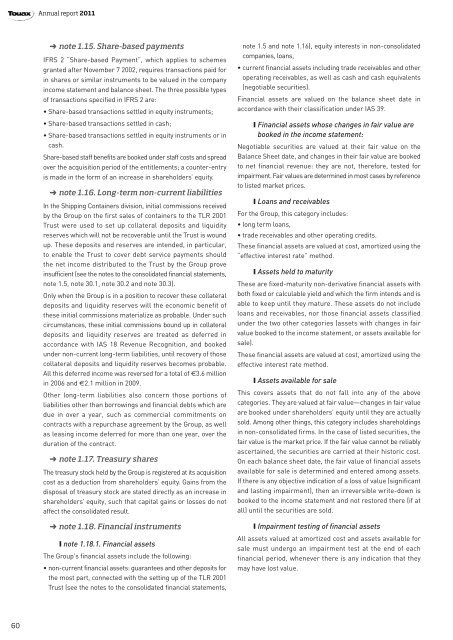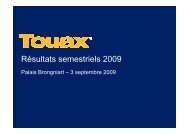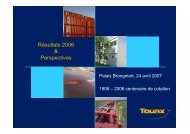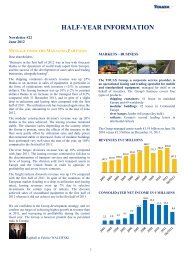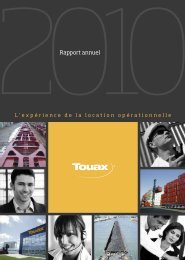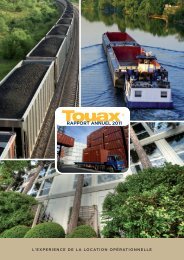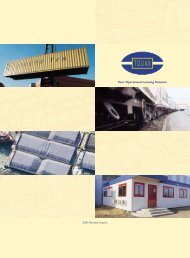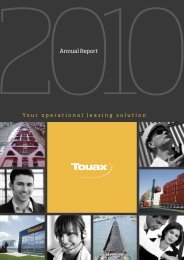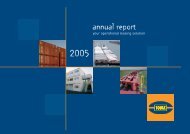2011 Annual report - touax group
2011 Annual report - touax group
2011 Annual report - touax group
Create successful ePaper yourself
Turn your PDF publications into a flip-book with our unique Google optimized e-Paper software.
<strong>Annual</strong> <strong>report</strong> <strong>2011</strong><br />
➜ note 1.15. Share-based payments<br />
IFRS 2 “Share-based Payment”, which applies to schemes<br />
granted after November 7 2002, requires transactions paid for<br />
in shares or similar instruments to be valued in the company<br />
income statement and balance sheet. The three possible types<br />
of transactions specified in IFRS 2 are:<br />
• Share-based transactions settled in equity instruments;<br />
• Share-based transactions settled in cash;<br />
• Share-based transactions settled in equity instruments or in<br />
cash.<br />
Share-based staff benefits are booked under staff costs and spread<br />
over the acquisition period of the entitlements; a counter-entry<br />
is made in the form of an increase in shareholders’ equity.<br />
➜ note 1.16. Long-term non-current liabilities<br />
In the Shipping Containers division, initial commissions received<br />
by the Group on the first sales of containers to the TLR 2001<br />
Trust were used to set up collateral deposits and liquidity<br />
reserves which will not be recoverable until the Trust is wound<br />
up. These deposits and reserves are intended, in particular,<br />
to enable the Trust to cover debt service payments should<br />
the net income distributed to the Trust by the Group prove<br />
insufficient (see the notes to the consolidated financial statements,<br />
note 1.5, note 30.1, note 30.2 and note 30.3).<br />
Only when the Group is in a position to recover these collateral<br />
deposits and liquidity reserves will the economic benefit of<br />
these initial commissions materialize as probable. Under such<br />
circumstances, these initial commissions bound up in collateral<br />
deposits and liquidity reserves are treated as deferred in<br />
accordance with IAS 18 Revenue Recognition, and booked<br />
under non-current long-term liabilities, until recovery of those<br />
collateral deposits and liquidity reserves becomes probable.<br />
All this deferred income was reversed for a total of €3.6 million<br />
in 2006 and €2.1 million in 2009.<br />
Other long-term liabilities also concern those portions of<br />
liabilities other than borrowings and financial debts which are<br />
due in over a year, such as commercial commitments on<br />
contracts with a repurchase agreement by the Group, as well<br />
as leasing income deferred for more than one year, over the<br />
duration of the contract.<br />
➜ note 1.17. Treasury shares<br />
The treasury stock held by the Group is registered at its acquisition<br />
cost as a deduction from shareholders’ equity. Gains from the<br />
disposal of treasury stock are stated directly as an increase in<br />
shareholders’ equity, such that capital gains or losses do not<br />
affect the consolidated result.<br />
➜ note 1.18. Financial instruments<br />
❙ note 1.18.1. Financial assets<br />
The Group's financial assets include the following:<br />
• non-current financial assets: guarantees and other deposits for<br />
the most part, connected with the setting up of the TLR 2001<br />
Trust (see the notes to the consolidated financial statements,<br />
note 1.5 and note 1.16), equity interests in non-consolidated<br />
companies, loans,<br />
• current financial assets including trade receivables and other<br />
operating receivables, as well as cash and cash equivalents<br />
(negotiable securities).<br />
Financial assets are valued on the balance sheet date in<br />
accordance with their classification under IAS 39.<br />
❙ Financial assets whose changes in fair value are<br />
booked in the income statement:<br />
Negotiable securities are valued at their fair value on the<br />
Balance Sheet date, and changes in their fair value are booked<br />
to net financial revenue: they are not, therefore, tested for<br />
impairment. Fair values are determined in most cases by reference<br />
to listed market prices.<br />
❙ Loans and receivables<br />
For the Group, this category includes:<br />
• long term loans,<br />
• trade receivables and other operating credits.<br />
These financial assets are valued at cost, amortized using the<br />
“effective interest rate” method.<br />
❙ Assets held to maturity<br />
These are fixed-maturity non-derivative financial assets with<br />
both fixed or calculable yield and which the firm intends and is<br />
able to keep until they mature. These assets do not include<br />
loans and receivables, nor those financial assets classified<br />
under the two other categories (assets with changes in fair<br />
value booked to the income statement, or assets available for<br />
sale).<br />
These financial assets are valued at cost, amortized using the<br />
effective interest rate method.<br />
❙ Assets available for sale<br />
This covers assets that do not fall into any of the above<br />
categories. They are valued at fair value—changes in fair value<br />
are booked under shareholders’ equity until they are actually<br />
sold. Among other things, this category includes shareholdings<br />
in non-consolidated firms. In the case of listed securities, the<br />
fair value is the market price. If the fair value cannot be reliably<br />
ascertained, the securities are carried at their historic cost.<br />
On each balance sheet date, the fair value of financial assets<br />
available for sale is determined and entered among assets.<br />
If there is any objective indication of a loss of value (significant<br />
and lasting impairment), then an irreversible write-down is<br />
booked to the income statement and not restored there (if at<br />
all) until the securities are sold.<br />
❙ Impairment testing of financial assets<br />
All assets valued at amortized cost and assets available for<br />
sale must undergo an impairment test at the end of each<br />
financial period, whenever there is any indication that they<br />
may have lost value.<br />
60


